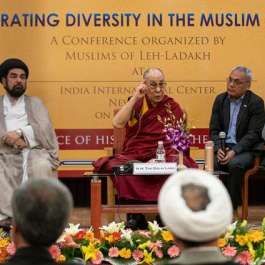
While we live under constant threats of violence, we must commit to creating spaces of refuge and repair. — Desiree Adaway
We are living in end times, through a kind of apocalypse. You can feel the falling apart—the economy in a slow-motion collapse, institutions crumbling, the exploitation of Mother Earth and the growing reality of extreme climate change. The outcome of the recent US presidential election would seem to cement this collapse in place or at least accelerate it.
Depending on the moment you catch me, I may either be in extreme distress about this process or finding my way toward some state of acceptance and equanimity.
I don’t believe this falling apart is necessarily a bad thing. But the consequences of it can be terribly hard, particularly for those folks who are already marginalized, and for the Earth herself. If we are at all awake to this, how can we not be in deep grief?
In Buddhism we often talk about “taking refuge.” This has a special meaning in our tradition. First of all, it’s about taking refuge in the three treasures: the Buddha, the Dharma and the Sangha. If there is an equivalent to baptism in Buddhism, this is it. There is often a formal ceremony to mark this ritual of taking refuge, to acknowledge that we are fully abiding in the spiritual foundation of these three aspects. “Buddha” is not so much the historical figure, although we offer him our gratitude and respect, as it is a recognition of the awakened being who resides within each of us. “Dharma” is “things as they are,” as well as the vast collection of teachings that come from the Buddha and his successors. “Sangha” is the community of our fellow practitioners.
But taking refuge can also be about placing our faith and energy in a simple truth—we are interconnected, all of us two-legged, four-legged, winged, crawling, and slithering beings, plant people, stone people, the elements. Because of that interdependence, whatever we can do to alleviate the suffering of another being will actually relieve our own suffering. In the same way, whatever we can do to plant the seeds of peace, justice, and happiness for others will increase our own sense of well-being.
During these end times, taking and offering refuge becomes especially important. We need to find some way to cope with this falling apart, a way that is more wholesome than the addictions and distractions we often turn to—I’m not proud to report that my sugar intake has been through the roof lately! Focusing on refuge is a generative way to support ourselves and others.
Refuge: a place of protection, a place that provides us with the safety we need to unfold our lives in the most authentic way.
I think back to a journey I took some years ago, pre-pandemic. I was traveling through the northeast US and took note of the ways that friends there were creating refuge:
• One offered a meditation group for his community on Sunday mornings—everyone welcome, no prior experience necessary.
• Another established an intimate residential community, the Breadloaf Mountain Zen Community, in the mountains of northern Vermont, where people from all generations could find refuge in practices of wisdom and compassion. One of Breadloaf’s projects is Gather, a “community living room” in downtown Middlebury that offers a welcoming space for all community.
• Another friend, whom I had known for more than 20 years, was creating a kind of refuge in a more informal way. Along with her husband and two teenage daughters, they opened up their home to young people whose families had less stability, and served up wholesome meals and yummy home-baked cookies. In the process, they created a safe and supportive space for those youth to explore how to respond to issues coming up in their schools, such as gun violence.
Making and taking refuge takes many forms:
• Physically: we can create altars and sacred spaces in our homes and on the land near us. We can feed ourselves and others food that is truly nourishing. We can grow community gardens that strengthen our local food supply.
• Spiritually: our meditation practice is a refuge during challenging times—returning to our breath, to our body, cultivating a sense of spaciousness and a courage to meet life just as it is. We so need this right now.
• Communally: we create refuge for each other when we watch out for those who are being persecuted and oppressed, and find ways to give them safe harbor. The people who supported Anne Frank’s family during the Holocaust serve as a memorable example. A more contemporary example is the organization No More Deaths (No Mas Muertas), which works along the US-Mexico border to protect human rights and provide humanitarian assistance to immigrants.
There are many other creative ways in which refuge can take form. A project I’ve been involved with in New Mexico over the past eight years, the Española Healing Foods Oasis, is a garden where native plants and herbs are given a safe home in which to grow and thrive, and the community comes together to tend this garden and learn about traditional foods. Everyone benefits from this kind of refuge.
What does creating and taking refuge look like for you? Leave a comment below and let’s explore this together.
See more
Bread Loaf Mountain Zen Community’s Gather Project
No More Deaths
Española Healing Foods Oasis
Related features from BDG
Should Children Take Refuge?
No Rest, but Refuge
Winter Reflections on the Nature of Refuge
Learning to Take Refuge
Taking Refuge
Within Chaos, There Is a Refuge for Meditation
Book Review: Chenxing Han’s Be the Refuge
Buddhistdoor View: Seeking Refuge in a Post-COVID World














